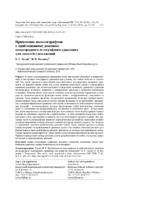| dc.contributor.author | Ласый, П. Г. | |
| dc.contributor.author | Мелешко, И. Н. | |
| dc.coverage.spatial | Минск | ru |
| dc.date.accessioned | 2019-10-03T11:52:54Z | |
| dc.date.available | 2019-10-03T11:52:54Z | |
| dc.date.issued | 2019 | |
| dc.identifier.citation | Ласый, П. Г. Применение полилогарифмов к приближенному решению неоднородного телеграфного уравнения для линии без искажений = Application of Polylogarithms to the Approximate Solution of the Inhomogeneous Telegraph Equation for the Distortionless Line / П. Г. Ласый, И. Н. Мелешко // Энергетика. Известия высших учебных заведений и энергетических объединений СНГ. – 2019. – № 5. – С. 413-421. | ru |
| dc.identifier.uri | https://rep.bntu.by/handle/data/57533 | |
| dc.description.abstract | В статье рассматривается смешанная задача для хорошо известного в электротехнике и электронике телеграфного уравнения при условии, что линия свободна от искажений. Эта задача сводится к аналогичной для одномерного неоднородного волнового уравнения. Ее решение можно найти как сумму решения смешанной задачи с однородными краевыми условиями для соответствующего однородного волнового уравнения и решения неоднородного волнового уравнения с однородными краевыми и нулевыми начальными условиями. Решения обеих задач можно отыскать методом разделения переменных в виде ряда по тригонометрическим функциям точки линии с коэффициентами, зависящими от времени. Такие решения неудобны для реального применения, поскольку требуют вычисления большого числа интегралов и трудно оценить погрешность их вычислений. Предлагается альтернативный способ решения этой задачи, основанный на использовании специальных функций – полилогарифмов, которые представляют собой комплексные степенные ряды со степенными же коэффициентами, сходящиеся в единичном круге. Точное решение задачи выражается в интегральной форме через мнимую часть полилогарифма первого порядка на единичной окружности, а приближенное – в виде конечной суммы через действительную часть дилогарифма и мнимую часть полилогарифма третьего порядка. Все указанные части полилогарифмов являются периодическими функциями, имеющими полиномиальные выражения соответствующих степеней на отрезке длиной в период. Это позволяет эффективно находить приближенное решение задачи. Также найдена простая и удобная оценка погрешности приближенного решения задачи. Она линейна относительно шага разбиения линии и шага разбиения временно́ го диапазона, на котором рассматривается задача. Оценка является равномерной по длине линии в каждый фиксированный момент времени. Приведен конкретный пример решения задачи разработанным способом, построены графики точного и приближенного решений. | ru |
| dc.language.iso | ru | ru |
| dc.publisher | БНТУ | ru |
| dc.title | Применение полилогарифмов к приближенному решению неоднородного телеграфного уравнения для линии без искажений | ru |
| dc.title.alternative | Application of Polylogarithms to the Approximate Solution of the Inhomogeneous Telegraph Equation for the Distortionless Line | ru |
| dc.type | Article | ru |
| dc.identifier.doi | 10.21122/1029-7448-2019-62-5-413-421 | |
| local.description.annotation | The paper deals with a mixed problem for the telegraph equation well-known in electrical engineering and electronics, provided that the line is free from distortion. This problem is reduced to the analogous one for the one-dimensional inhomogeneous wave equation. Its solution can be found as the sum of the solution for a mixed homogeneous boundary value problem for the corresponding homogeneous wave equation and for the solution of a non-homogeneous wave equation with homogeneous boundary data and zero initial conditions. Solutions to both problems can be found by separating the variables in the form of a series of trigonometric functions of the line point with time-dependent coefficients. Such solutions are inconvenient for real application because they require calculation of a large number of integrals, and it is difficult to estimate the miscalculation. An alternative method for solving this problem is proposed, based on the use of special functions, viz. polylogarithms, which are complex power-series with power coefficients converging in a unit circle. The exact solution of the problem is expressed in the integral form via the imaginary part of the first-order polylogarithm on the unit circle, and the approximate one is expressed in the form of a finite sum via the real part of the dilogarithm and the imaginary part of the third-order polylogarithm. All these parts of the polylogarithms are periodic functions that have polynomial expressions of the corresponding powers on the segment of the length equal to the period. This makes it possible to effectively find an approximate solution to the problem. Also, a simple and convenient error estimate of the approximate solution of the problem is found. It is linear with respect to the step of splitting the line and the step of splitting the time range in which the problem is considered. The score is uniform along the length of the line at each fixed point of time. A concrete example of solving the problem according to the proposed mode is presented; graphs of exact and approximate solutions are constructed. | ru |

